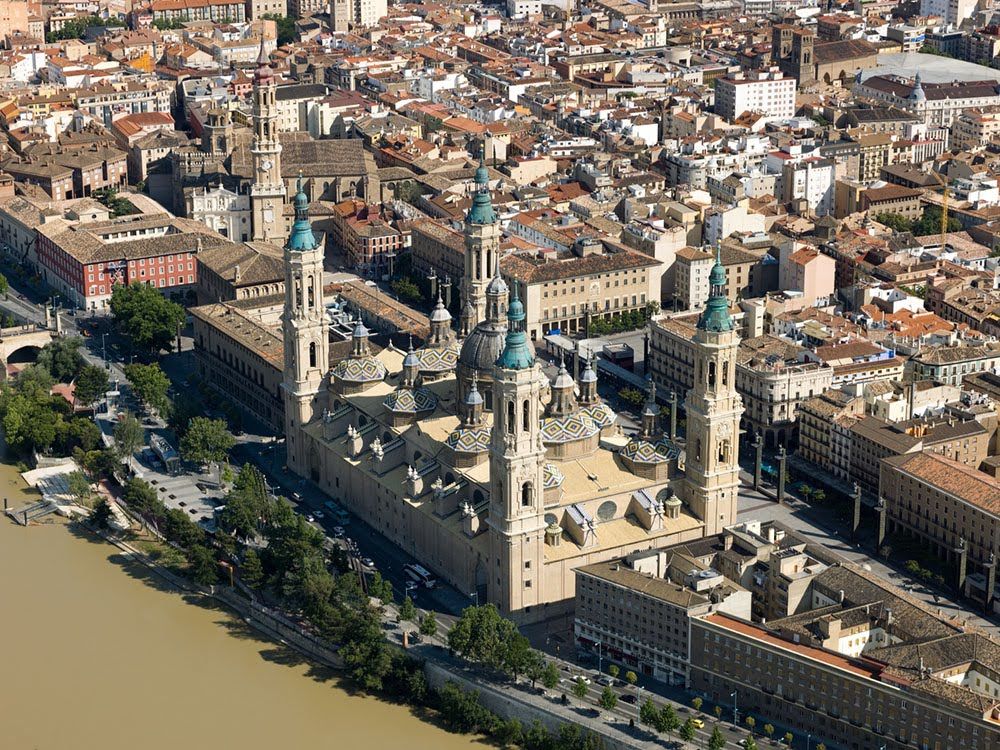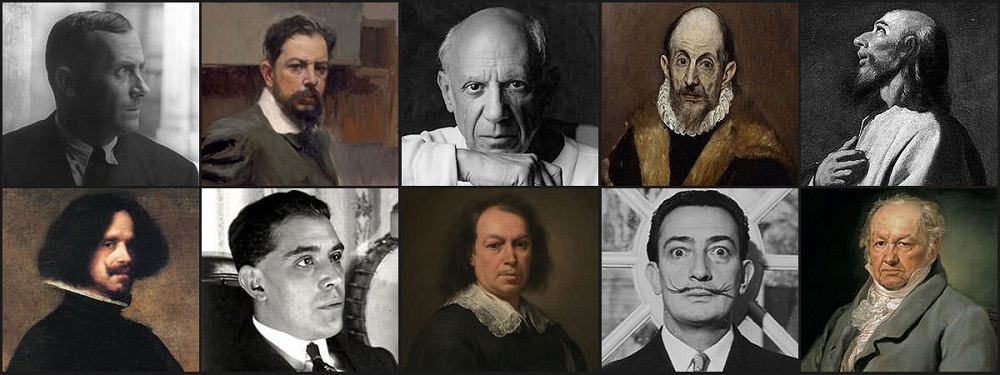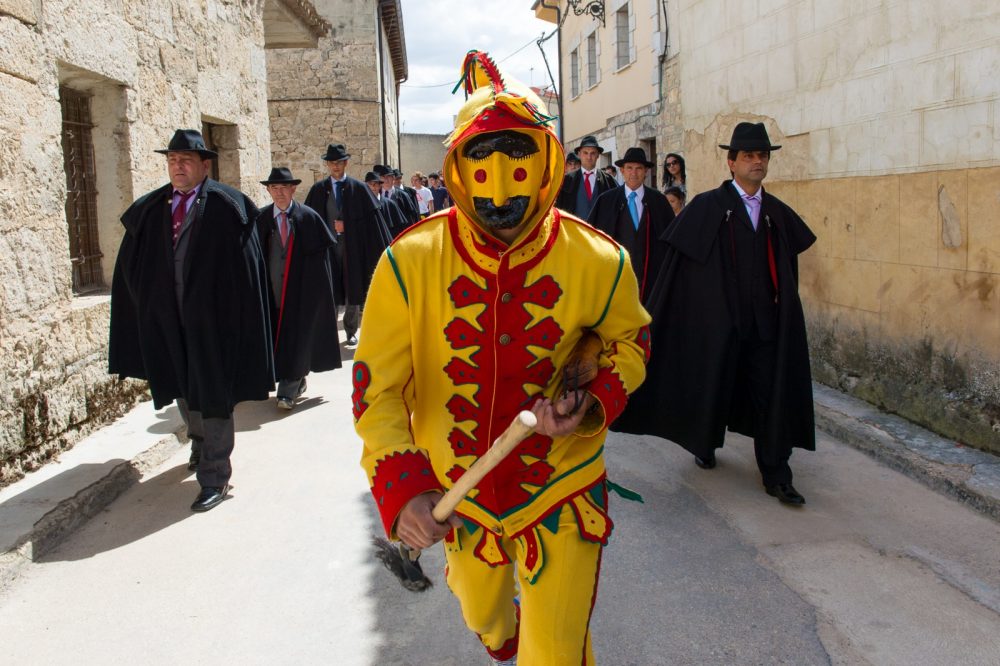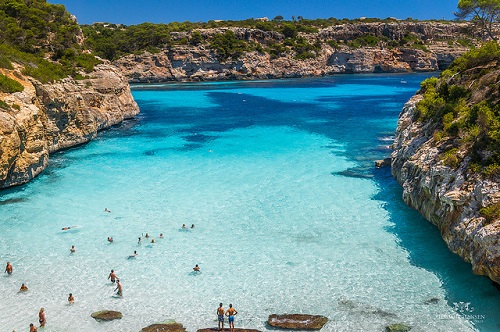Zaragoza city lies in the northeastern part of Spain, in Aragón region. This city is popular for its rich historical heritage left by the Romans and Moors. As well, it is home to the stunning landmarks, palaces, and museums.
Zaragoza is a very pleasant city to explore, so here are our the top 10 best things to see in Zaragoza, Spain.
1- Basílica de Nuestra Señora del Pilar :
 via – infovaticana
via – infovaticana
The Basílica de Nuestra Señora del Pilar is one of the best things to see in Zaragoza. The basilica has a Baroque-style architecture with rising towers and its location along the banks of the Ebro River gives it the most impressive views.
The basilica is the most important pilgrimage churches in Spain after Santiago de Compostela. As well, It is the first church dedicated to the Virgin Mary. Since the Middle Ages, pilgrims have moved here to honor an image of the Virgin Mary and the Sagrada Columna, a pillar of jasper stone that is associated with a Marian apparition.
This imposing cathedral is surly magnificent inside and outside. Be amazed by the murals, architecture and majestic interiors, which holds precious 2 major objects of veneration. First is the Virgen del Pilar figure behind a mantelpiece is taken out and presented to the faithful each year on January 2nd, celebrating the date when the Virgin appeared. The Sagrada Columna is the second object, known as “El Pilar” is now adorned with fanciful silver plating.
2- Museo del Foro de Caesaraugusta:
 via – zaragozago
via – zaragozago
The museum situated on the site of the archaeological excavations, underneath the Plaza de la Seo. Besides, it exhibits the life of Caesaraugusta that dates back to the era of Emperor Tiberius.
Visitors will discover artifacts that show elements of the old market, pipes, walls of shops, and a sewer system. The displays are complemented by educational information and an interesting audio-visual presentation.
3- Cathedral de San Salvador:
 via – steemit
via – steemit
The cathedral de san Salvador or cathedral de la Seo was built in the 12th century on the site of the Roman temple of the Forum. It became a large Muslim mosque during the Moorish era, before being transformed to a Romanesque church in the 12th century. The present cathedral’s tower is the oldest mosque minaret, and the remains of Romanesque elements still exist on the exterior of the apses.
La Seo Cathedral contains five naves. The Moorish remains are seen in the chancel and some of the archways. The Gothic style demonstrated at the choir, and the Capilla del Santo Cristo is a masterpiece of Renaissance architecture. Adding to the architectural mixture are the Baroque details on the tower and neoclassical facade.
Moreover, the cathedral holds an imposing Tapestry collection which is considered to be one of the finest in the world. Besides, the cathedral has 63 precious Flemish tapestries and six works of heraldic embroidery of very high quality, ranging from medieval to Renaissance and Baroque. The museum exhibits 11 of the tapestries, as well as other objects of religious art including metalwork and reliquary busts.
4- Educational Museum of Origami in Zaragoza (EMOZ):
 via – birdwatchingzaragoza
via – birdwatchingzaragoza
Zaragoza’s Origami Museum is one of the best things to see in Zaragoza. This museum is the first and unique in Europe, where you can see the history of origami, workshops, techniques and permanent exhibition that is renewed every 3 months.
This museum holds small pieces of paper that represent animals, film characters, and nature that occupy a whole room. Besides, it includes creations made by some of the world’s most renowned origami artists, including Akira Yoshihide Momotani, Yoshizawa, and Vicent Floderer. In addition to the permanent collections, the museum holds themed displays, which focus on different materials and artists.
5- Pablo Serrano Museum:
 via – hisour
via – hisour
The Pablo Serrano Museum is known as The Aragonese Institute of Contemporary Art and Culture (IAACC), is a museum devoted to modern and contemporary art and showcases a large collection of works by the Aragonese sculptor Pablo Serrano. Besides, the museum located in the old offices of the provincial hospice, known as Hogar Pignatelli, which were renovated by the Aragonese architect José Manuel Pérez Latorre.
In its interior, it is displayed to the public an ample sample of the work of Pablo Serrano. The permanent showcase 140 drawings and sculptures which reflect the evolution of the artist’s creativity and innovation. The museum also exhibits various works like Pablo Serrano’s wife, Juana Francés; contemporary graphic artworks, and a range of Painting of Santiago Lagunas.
Besides, the museum also holds temporary exposition of contemporary painting and sculpture and also features other artists’ work, including pieces by Pablo Picasso, Alexander Calder, and Andy Warhol. As well as it also has a library and an area dedicated to the realization of workshops, which have become a benchmark in the field.
6- Museo del Teatro Romano:
 via – zaragozago
via – zaragozago
The Caesaraugusta Theatre was discovered in 1972, the site located in the ancient Roman city and enclosed in a special exhibition space. Today, visitors can see the remains of this theatre which has great social importance to the ancient Roman’s life. Furthermore, the archaeological ruins give a sense of the splendor of the original theater and the lifestyle of antiquity. Also on the showcase is interesting artifacts found at the site, such as decorative sconces.
As well as, on the ground floor, visitors can enjoy picturesque views of the excavation process, while in the basement, audiovisual presentations and 3D models demonstrate what the theatre would have been like back in Roman times. On the top floor, another audiovisual show provides visitors information about the different cultures that have lived around the theatre through its lifetime.
7- Palacio de la Aljafería:
 via – getyourguide
via – getyourguide
The Aljafería Palace is one of the magnificent things to see in Zaragoza. This castle is the ancient one in Spain, also built in the 11th century by a Muslim ruler. Besides, it is designed with elegant Arabic arches and intricate carvings and has some of the best Mudéjar elements outside of Andalusia. Throughout the years, it became the palace of the kings of Aragon but today, it’s the head office to Aragon’s regional Parliament.
8- Zaragoza Museum:
 via – inspain
via – inspain
The Zaragoza Museum is accommodated in a grand neo-Renaissance building, which was built for the 1908 Universal Exposition. Besides, the museum divides into two sections; the first is the archaeology section, where visitors can see archaeological ruins from Aljafería Palace, as well as the head of Augustus from Tarazona. The other section is the fine arts exhibits some important works by the Spanish painters like Francisco de Goya and Paradilla and others dating back from the 12th century to the modern-day.
9- Fluval Aquarium of Zaragoza:
 via – inspirock
via – inspirock
The Zaragoza Aquarium is on of the best things to see in Zaragoza. It is the biggest freshwater aquarium in Europe, hosts over 5,000 animals representing more than 350 species of aquatic life. The central aquarium contains nearly two million liters of water, symbolizing the primal waters from which life first evolved. Besides, there is a symbolic glacier nourishes the various species, respecting their unique environment that replicates a major ecosystem on the planet, including great rivers like the Nile and the Amazon.
10- Museo de las Termas Públicas :
 via – laventanadelarte
via – laventanadelarte
The thermal baths of Caesaraugusta were playing an important role in the ancient Romans more than just a place for bathing, but a place to play sports, read, and listen to music or poetry. The baths included hot-water and cold-water, so the bathers could alternate between the two baths, but most started with hot and then finished with a cold.
Today, visitors can discover the history of the baths, as well as some of their ruins in this Public Baths Museum.


 Top 10 Most Famous Spanish Artists and their Arts
Top 10 Most Famous Spanish Artists and their Arts
 El Colacho, the Baby Jumping Festival in Murcia Spain
El Colacho, the Baby Jumping Festival in Murcia Spain
 Discover The Most Beautiful Places In Mallorca, Spain
Discover The Most Beautiful Places In Mallorca, Spain